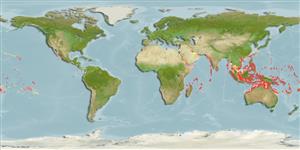Preferred temperature (Ref.
123201): 25.4 - 29, mean 28 °C (based on 654 cells).
Phylogenetic diversity index (Ref.
82804): PD
50 = 0.5000 [Uniqueness, from 0.5 = low to 2.0 = high].
Bayesian length-weight: a=0.00102 (0.00046 - 0.00225), b=3.06 (2.88 - 3.24), in cm total length, based on all LWR estimates for this body shape (Ref.
93245).
Trophic level (Ref.
69278): 3.4 ±0.4 se; based on size and trophs of closest relatives
Widerstandsfähigkeit (Ref.
120179): mittel, Verdopplung der Population dauert 1,4 - 4,4 Jahre. (Preliminary K or Fecundity.).
Fishing Vulnerability (Ref.
59153): Low to moderate vulnerability (35 of 100).
Nutrients (Ref.
124155): Calcium = 60.3 [33.5, 97.1] mg/100g; Iron = 0.698 [0.420, 1.147] mg/100g; Protein = 18.2 [15.2, 21.2] %; Omega3 = 0.111 [0.051, 0.316] g/100g; Selenium = 38.9 [21.1, 80.8] μg/100g; VitaminA = 97.6 [27.9, 327.8] μg/100g; Zinc = 1.2 [0.8, 1.7] mg/100g (wet weight);
